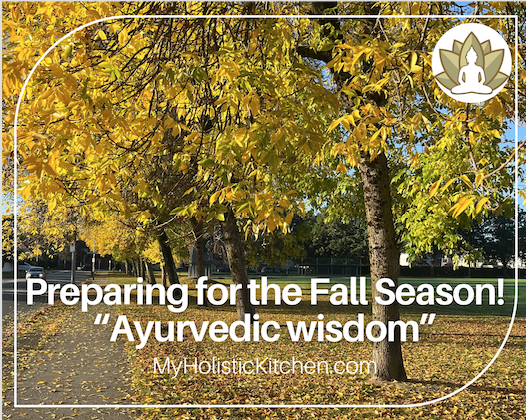
As I stepped outside this morning, the cool breeze carried a gentle chill, dry leaves rustled beneath my feet, and the earth felt alive with change. It was a quiet reminder — Autumn is here, inviting us to slow down, realign, and reconnect with nature’s rhythm.
In Ayurveda, this seasonal shift is beautifully explained through Ritucharya, the ancient practice of living in harmony with the seasons. Just as the trees let go of their leaves, we too are encouraged to release what no longer serves us and nourish body, mind, and spirit to stay balanced and grounded.
Fall is known as The Vata Season, governed by the elements of air and ether. These bring qualities of cold, dryness, lightness, and movement, which are also the main traits of Vata dosha.When Vata is in balance, it sparks creativity, enthusiasm, and adaptability. But when aggravated, it can lead to dry skin, constipation, anxiety, restlessness, and difficulty focusing. Even if you don’t have a Vata constitution, everyone feels its effects during autumn.
Ayurveda reminds us that “like increases like.” The windy, cool, and unpredictable weather of fall can easily disturb Vata. To stay healthy, we must balance it with the opposite energies — warmth, moisture, nourishment, and stability.
1. Ayurvedic Fall Diet: Nourish and Ground Yourself
Fall calls for foods that are warm, oily, and grounding. Avoid cold salads, dry snacks, and raw foods that aggravate dryness and lightness in the body.
Include more of:
- Warm soups, stews, and khichari
- Root vegetables like carrots, beets, and sweet potatoes
- Whole grains such as rice, quinoa, and oats
- Healthy fats like ghee, avocado, and sesame oil
- Warming spices — ginger, cinnamon, turmeric, cumin, and cardamom
Avoid or minimize:
- Cold beverages, raw salads, dry crackers, and processed foods
Favor the sweet, sour, and salty tastes to pacify Vata, while reducing bitter, astringent, and pungent tastes that can increase imbalance.
Tip: Fall is a wonderful time to do a gentle Ayurvedic cleanse with Khichari — a nourishing one-pot meal that supports digestion and detoxification.
2. Daily Routine: Create Calm and Stability
Vata thrives on movement and change, so routine becomes the medicine that grounds it.
Try this Ayurvedic fall routine:
- Wake up with the sun — around 6:30–7:00 AM
- Begin your day with warm water or ginger tea
- Practice gentle yoga, pranayama, or a mindful walk in nature
- Eat meals at regular times
- Unplug early in the evening and wind down with soft lighting, herbal tea, or journaling
- Sleep early — ideally by 10 PM
Regularity helps calm the nervous system, improve digestion, and keep energy steady throughout the day.
3. Ayurvedic Self-Care Rituals: Moisturize and Warm the Body
To offset the dryness of fall, indulge in nourishing and warming self-care rituals.
- Abhyanga (Oil Massage): Massage your body daily with warm sesame or almond oil before showering. It deeply moisturizes, improves circulation, and calms the mind.
- Stay Warm: Dress in layers and protect yourself from cold, dry wind.
- Hydrate: Sip on warm water or herbal teas throughout the day — avoid cold or carbonated drinks.
These simple rituals make a remarkable difference in how balanced and grounded you feel.
4. Mind and Emotions: Stay Grounded and Grateful
As nature sheds its leaves, we are reminded to let go and create space for renewal. Vata’s airy nature can cause a scattered or anxious mind, so this is the season to slow down, reflect, and reconnect inward.
Support your mental and emotional balance by:
- Practicing meditation, journaling, or simply sitting in silence
- Reducing screen time and overstimulation
- Listening to calming music or nature sounds
- Practicing gratitude — reflect on what you’ve harvested this year, both literally and metaphorically
Gratitude cultivates warmth and contentment, grounding the restless energy of Vata.
Embrace the Wisdom of Autumn
Fall is nature’s invitation to pause, reset, and restore. By aligning with Ayurvedic principles — warming your body, calming your mind, and embracing nourishing routines — you can transition gracefully through the season.
This autumn, let Ayurveda guide you toward balance, vitality, and inner peace.
Wrap yourself in a cozy shawl, sip your spiced tea, and remember: just like the falling leaves, you too can let go and thrive.
The above recommendations for The Fall Season are appropriate for most people during the Fall. For additional considerations specific to your constitution, CONNECT with us for a personalized assessment!
If you are new to Ayurveda and want to know if Ayurveda is right for you, do take our short introductory course on What’s your dosha?
Learn the basics of Ayurvedic diet and lifestyle through our self-paced online course “Basics of Ayurveda”
Craving for more……
Check out all of OUR SELF-PACED ONLINE COURSES that include a perfect blend of Holistic Nutrition and ancient Ayurvedic wisdom!
- THE COMPLETE GUIDE TO STRESS MANAGEMENT
- THE COMPLETE MASTERCLASS ON THE ART OF LIVING
- TAKE CONTROL OF YOUR BLOOD SUGAR NATURALLY
- THE COMPLETE GUIDE TO MENOPAUSE
- THE COMPLETE GUIDE TO MANAGING BLOOD PRESSURE NATURALLY
- BASICS OF HEALTHY EATING
- DIGESTION- The Key to good Health!
- MANAGE BACK PAIN USING DIET & LIFESTYLE
- WHAT’S YOUR DOSHA?
- BASICS OF AYURVEDA
- THE SCIENCE BEHIND MENOPAUSAL SYMPTOMS!
- FOODS FOR BALANCING HORMONES!
- LIFESTYLE SOLUTIONS TO MENOPAUSAL SYMPTOMS!
- HOLISTIC SOLUTIONS FOR HAIR LOSS
OCTOBER SALE: 75% OFF on any of our online courses!
USE CODE: DIWALI2025
NAMASTE,

Preeti Syal
M.Sc., R.H.N., Certified Ayurvedic Lifestyle Consultant
The content provided in my blogs are for knowledge sharing purposes only and is not intended to be a substitute for professional medical advice, diagnosis or treatment.


